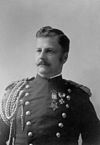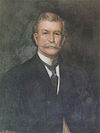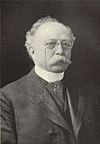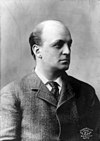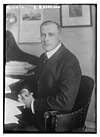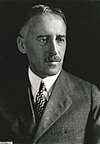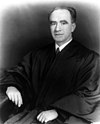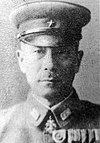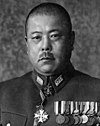| No.
|
Portrait
|
Name
|
Tenure start
|
Tenure end
|
Monarch
|
| (53)
|

|
Mariano Fernández de Folgueras
Acting Governor-General
(1766–1823)
|
September 16,
1821
|
October 30,
1822
|
Ferdinand VII
(1813–1833)
|
| 54
|

|
Juan Antonio Martínez
|
October 30,
1822
|
October 14,
1825
|
| 55
|

|
Mariano Ricafort Palacín y Abarca
(1776–1846)
|
October 14,
1825
|
December 23,
1830
|
| 56
|

|
Pasqual Enrile y Alcedo
(1772–1836)
|
December 23,
1830
|
March 1,
1835
|
Isabella II
(1833–1868)
|
| 57
|

|
Gabriel de Torres
|
March 1,
1835
|
April 23,
1835
|
| 58
|

|
Joaquín de Crame
Acting Governor-General
|
April 23,
1835
|
September 9,
1835
|
| 59
|

|
Pedro Antonio Salazar Castillo y Varona
Acting Governor-General
|
September 9,
1835
|
August 27,
1837
|
| 60
|

|
Andrés García Camba
(1793–1861)
|
August 27,
1837
|
December 29,
1838
|
| 61
|

|
Luis Lardizábal
|
December 29,
1838
|
February 14,
1841
|
| 62
|
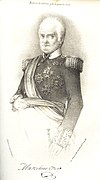
|
Marcelino de Oraá Lecumberri
(1788–1851)
|
February 14,
1841
|
June 17,
1843
|
| 63
|

|
Francisco de Paula Alcalá de la Torre
|
June 17,
1843
|
July 16,
1844
|
| 64
|

|
Narciso Clavería y Zaldúa
1st Count of Manila
(1795–1851)
|
July 16,
1844
|
December 26,
1849
|
| 65
|

|
Antonio María Blanco
Acting Governor-General
|
December 26,
1849
|
July 29,
1850
|
| 66
|

|
Juan Antonio de Urbiztondo, Marquis of La Solana
(1803–1857)
|
July 29,
1850
|
December 20,
1853
|
| 67
|

|
Ramón Montero y Blandino
Acting Governor-General
|
December 20,
1853
|
February 2,
1854
|
| 68
|

|
Manuel Pavía y Lacy
1st Marquess of Novaliches
(1814–1896)
|
February 2,
1854
|
October 28,
1854
|
| (67)
|

|
Ramón Montero y Blandino
Acting Governor-General
|
October 28,
1854
|
November 20,
1854
|
| 69
|

|
Manuel Crespo y Cebrían
(1793–1868)
|
November 20,
1854
|
December 5,
1856
|
| (67)
|

|
Ramón Montero y Blandino
Acting Governor-General
|
December 5,
1856
|
March 9,
1857
|
| 70
|

|
Fernando de Norzagaray y Escudero
(1808–1860)
|
March 9,
1857
|
January 12,
1860
|
| 71
|

|
Ramón María Solano y Llanderal
|
January 12,
1860
|
August 29,
1860
|
| 72
|

|
Juan Herrera Dávila
Acting Governor-General
|
August 29,
1860
|
February 2,
1861
|
| 73
|

|
José Lémery e Ibarrola
(1811–1886)
|
February 2,
1861
|
July 7,
1862
|
| 74
|

|
Salvador Valdés
Acting Governor-General
|
July 7,
1862
|
July 9,
1862
|
| 75
|

|
Rafaél de Echagüe y Bermingham
(1815–1915)
|
July 9,
1862
|
March 24,
1865
|
| 76
|

|
Joaquín del Solar e Ibáñez
Acting Governor-General
|
March 24,
1865
|
April 25,
1865
|
| 77
|

|
Juan de Lara e Irigoyen
|
April 25,
1865
|
July 13,
1866
|
| 78
|

|
José Laureano de Sanz y Posse
Acting Governor-General
(1819–1898)
|
July 13,
1866
|
September 21,
1866
|
| 79
|

|
Antonio Osorio y Mallén
(1808-1881)
Acting Governor-General
|
September 21,
1866
|
September 27,
1866
|
| (76)
|

|
Joaquín del Solar e Ibáñez
|
September 27,
1866
|
October 26,
1866
|
| 80
|

|
José de la Gándara y Navarro
(1820–1885)
|
October 26,
1866
|
June 7,
1869
|
Francisco Serrano
1st Duke of la Torre
Regent
(1868–1870)
|
| (81)
|

|
Manuel Maldonado
Acting Governor-General
|
June 7,
1869
|
June 23,
1869
|
| 82
|
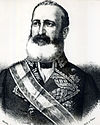
|
Carlos María de la Torre y Navacerrada
(1809–1879)
|
June 23,
1869
|
April 4,
1871
|
Amadeo I
(1870–1873)
|
| 83
|
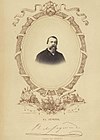
|
Rafael Izquierdo y Gutiérrez
(1820–1883)
|
April 4,
1871
|
January 8,
1873
|
| (84)
|

|
Manuel MacCrohon
Acting Governor-General
|
January 8,
1873
|
January 24,
1873
|
| 85
|

|
Juan Alaminos y Vivar
(1813–1899)
|
January 24,
1873
|
March 17,
1874
|
Estanislao Figueras
President
(1873)
|
Francesc Pi i Margall
President
(1873)
|
Nicolás Salmerón y Alonso
President
(1873)
|
Emilio Castelar
President
(1873–1874)
|
Francisco Serrano
President
(1874)
|
| 86
|

|
Manuel Blanco Valderrama
Acting Governor-General
|
March 17,
1874
|
June 18,
1874
|
| 87
|
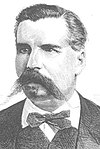
|
José Malcampo
3rd Marquess of San Rafael
(1828–1880)
|
June 18,
1874
|
February 28,
1877
|
Alfonso XII
(1874–1885)
|
| 88
|

|
Domingo Moriones y Murillo
(1823–1881)
|
February 28,
1877
|
March 20,
1880
|
| 89
|

|
Rafael Rodríguez Arias
Acting Governor-General
(1819–1898)
|
March 20,
1880
|
April 15,
1880
|
| 90
|

|
Fernando Primo de Rivera
1st Marquess of Estella
(1831–1921)
|
April 15,
1880
|
March 10,
1883
|
| (91)
|

|
Emilio Molíns
Acting Governor-General
(1824–1889)
|
March 10,
1883
|
April 7,
1883
|
| 92
|

|
Joaquín Jovellar y Soler
(1819–1892)
|
April 7,
1883
|
April 1,
1885
|
| (91)
|

|
Emilio Molíns
Acting Governor-General
(1824–1889)
|
April 1,
1885
|
April 4,
1885
|
| 92
|

|
Emilio Terrero y Perinat
(1827–1890)
|
April 4,
1885
|
April 25,
1888
|
Maria Christina
Regent
(1885–1886)
|
Alfonso XIII
(1886–1931)
|
| 93
|

|
Antonio Moltó y Díaz Berrio
Acting Governor-General
|
April 25,
1888
|
June 4,
1888
|
| 94
|

|
Federico Lobatón y Prieto
Acting Governor-General
|
June 4,
1888
|
June 5,
1888
|
| 95
|
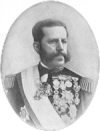
|
Valeriano Weyler
1st Marquess of Tenerife
(1838–1930)
|
June 5,
1888
|
November 17,
1891
|
| 96
|

|
Eulogio Despujol y Dusay
1st Count of Caspe
(1834–1907)
|
November 17,
1891
|
March 1,
1893
|
| 97
|

|
Federico Ochando
Acting Governor-General
(1848–1929)
|
March 1,
1893
|
May 4,
1893
|
| 98
|

|
Ramón Blanco
1st Marquess of Peña Plata
(1833–1906)
|
May 4,
1893
|
December 13,
1896
|
| 99
|

|
Camilo Garcia de Polavieja
1st Marquess of Polavieja
Acting Governor-General
(1838–1914)
|
December 13,
1896
|
April 15,
1897
|
| 100
|

|
José de Lachambre
Acting Governor-General
(1846–1903)
|
April 15,
1897
|
April 23,
1897
|
| (90)
|

|
Fernando Primo de Rivera
1st Marquess of Estella
(1831–1921)
|
April 23,
1897
|
April 11,
1898
|
| 101
|

|
Basilio Augustín[1]
(1840–1910)
|
April 11,
1898
|
July 24,
1898
|
| 102
|
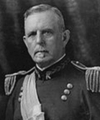
|
Fermín Jáudenes[1]
Acting Governor-General
(1836–1915)
|
July 24,
1898
|
August 13,
1898
|
| 103
|

|
Francisco Rizzo[1]
Acting Governor-General
(1831–1910)
|
August 13,
1898
|
September
1898
|
| 104
|

|
Diego de los Ríos[1]
Acting Governor-General
(1850–1911)
|
September
1898
|
December 10,
1898
|



























































































